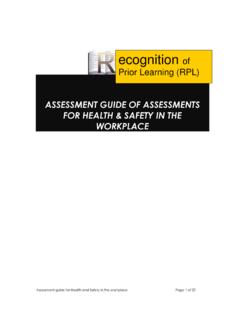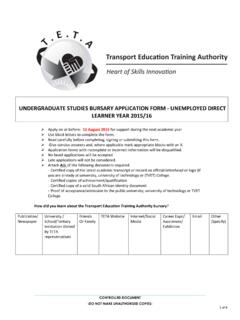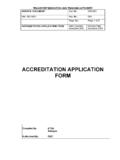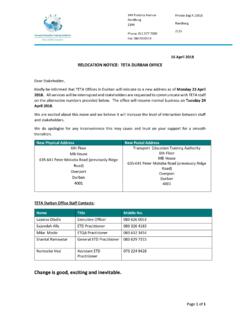Transcription of SECTOR SKILLS PLAN UPDATE 31 JANUARY 2014
1 SECTOR SKILLS plan UPDATE 31 JANUARY 2014 Page 1 of 97 SYNOPSIS The SECTOR SKILLS plan has been prepared in accordance with the guidelines of the National SKILLS Development Strategy (NSDS III) and the DHET Guide to the Process and Timeframes. The principal aim of this SECTOR SKILLS plan is to guide and inform SKILLS development initiatives in the designated SECTOR . It is the outcome of a thorough research process and extensive stakeholder consultation and engagement. The SECTOR SKILLS plan informs the strategic and annual plans of the SETA and serves as a signpost for policy-making by Council. Firstly, we have adopted an evidence-led research approach for identifying and anticipating scarce and critical SKILLS . This has been achieved by devising a customised methodology to identify scarce SKILLS in the SECTOR .
2 This is explained clearly in Chapter Two of the document. In the future we intend refining the research methodology to serve as an early warning system for anticipating SKILLS shortages in the transport SECTOR . We want to be in a position to justify our choices. Secondly, we have given consideration to national policy issues outlined in the New Growth Path, HRDSA, National Development plan , IPAP, National SKILLS Development Strategy and the SKILLS Accord in the SSP. These priorities inform SKILLS development projects in the SETA. Thirdly, we have advised our research team to produce an SSP that is easy-to-read. The primary target audience is employers and labour unions. The secondary audience is public entities, NGOs, public entities, CBOs, investors, training providers and other interest groups. Our SSP is not written in a thesis or peer-reviewed academic journal style, but rather as a document which is in the public domain for all to read.
3 We want employers and trade unions to engage with the document. Fourthly, the SSP is concise; visual and graphic; uses simple language; and easy to understand. All this is achieved without compromising the integrity, accuracy and thoroughness of the research. The SSP is analytical, incisive and insightful, not purely descriptive in nature. This enables a deeper understanding of occupational and SKILLS needs. We have balanced quantitative research with qualitative insights. Finally, we have considered the DHET feedback on the previous SSP (2012) and the Continuous Improvement plan and responded accordingly. The SECTOR SKILLS plan is submitted to the Minister of Higher Education and Training in partial compliance with the requirements of the SKILLS Development Act 1998 and the National SKILLS Development Strategy (NSDS III). The SECTOR SKILLS plan is endorsed by duly authorised representatives. Page 2 of 97 CHAIRPERSON: TETA BOARD _____ Mr June Dube Date: 31 JANUARY 2014 TETA CHIEF EXECUTIVE OFFICER _____ Mrs Maphefo Anno-Frempong Date: 31 JANUARY 2014 Page 3 of 97 CONTENTS SYNOPSIS.
4 1 EXECUTIVE SUMMARY .. 8 CHAPTER ONE: SECTOR PROFILE .. 11 INTRODUCTION .. 11 STAKEHOLDER ENGAGEMENT .. 11 SCOPE OF COVERAGE (SIC CODES) .. 12 PROFILE OF THE TRANSPORT SECTOR .. 16 Key Features of the Transport SECTOR .. 17 LABOUR MARKET CONTEXT .. 18 Employment by Industry and SECTOR .. 19 Transport SECTOR Employment .. 20 Employment by Sub- SECTOR in Transport .. 21 Employment by Province .. 21 Transport SECTOR Enterprises by size and province .. 22 Transport SECTOR Enterprises by size and chamber .. 23 Employment by Race, Gender and Disability .. 24 Employment Equity .. 29 Terms of Employment .. 30 ALIGNMENT WITH NATIONAL STRATEGIES .. 31 DRIVERS OF CHANGE .. 32 Decent Work .. 32 Greening the Transport SECTOR .. 33 Small Enterprise Development .. 34 Strategic Integrated Project (SIP) .. 35 Southern African Rail Network .. 36 HIV/AIDS .. 37 CONCLUSION .. 38 CHAPTER TWO: RESEARCH DESIGN AND METHODOLOGY .. 40 INTRODUCTION.
5 40 LABOUR MARKET INTELLIGENCE SYSTEM .. 40 RESEARCH DESIGN .. 41 RESEARCH METHODS .. 42 Page 4 of 97 Interviews with Key Informants .. 43 Expert Workshop .. 43 WSP/ATR .. 43 Regional Workshops .. 44 Employer Bodies and Trade Unions .. 44 Career Junction Index .. 44 CRITERIA FOR DETERMINING SCARCE SKILLS .. 45 CONCLUSION .. 47 CHAPTER THREE: SUPPLY OF SKILLS .. 48 ANALYSING LABOUR SUPPLY-DEMAND .. 48 CareerJunction Index .. 48 SUPPLY OF 49 Employment by Occupation and Industry .. 49 Education Levels .. 50 WSP 2013/ 2014 and ATR 2012/2013 .. 52 Race Profile by Occupational Levels .. 52 Training by Race, Age and Region .. 53 CHAPTER FOUR: DEMAND FOR SKILLS .. 62 SKILLS DEMAND .. 62 INDUSTRIES DISPLAYING MAJOR DEMAND .. 64 INDUSTRY TRENDS .. 64 DEMAND FOR SPECIFIC OCCUPATIONAL FIELDS .. 66 CHAPTER FIVE: SCARCE AND CRITICAL SKILLS .
6 68 SCARCE 68 CRITICAL SKILLS .. 80 CONCLUDING REMARKS .. 82 CHAPTER SIX: STRATEGIC FRAMEWORK .. 84 PERFORMANCE MONITORING AND EVALUATION .. 84 STRATEGIC FRAMEWORK .. 85 96 Page 5 of 97 FIGURES Figure 1: Proportion of Disabled Employees .. 28 Figure 2: High Skilled Workers by Race .. 29 Figure 3: Low Skilled Workforce by Race .. 30 Figure 4: Research Design to determine SKILLS in Demand .. 41 Figure 5: Methods used to UPDATE the SSP .. 42 Figure 6: Methodology used for Assessment of SKILLS in Demand .. 46 Figure 7: Education Levels in Transport SECTOR .. 51 Figure 8: Occupation-Race Transport SECTOR .. 52 Figure 9: Training by Race .. 54 Figure 10: Completed Training by Age .. 55 Figure 11: Planned Training by Province and Race .. 56 Figure 12: Planned Training by Occupation and Race .. 57 Figure 13: Industries in terms of major demands.
7 64 TABLES Table 1:Demarcation of Standard Industry Classification Codes .. 12 Table 2: Modal Classification of TETA Chambers .. 13 Table 3: Employment by Industry and SECTOR .. 19 Table 4: Employment in Transport Industry and Total Employment 19 Table 5: Employment by Sub-Sectors in Transport Industry, 2013 .. 21 Table 6: Employment in Transport Industry by Province, 2013 .. 21 Table 7: Number of Enterprises in Transport SECTOR by Size and Province .. 22 Table 8: Number of Enterprises in the Transport SECTOR by Size and Chamber .. 23 Table 9: Employment by Race and Gender, 2012-2013 .. 24 Table 10: Employment in Transport Industry by Gender, 2008-2013 (000') .. 25 Page 6 of 97 Table 11: Employment in Transport Industry by Age and Gender .. 25 Table 12: High-Skilled Workforce by Age .. 26 Table 13: Low-Skilled Workforce by Age .. 27 Table 14: High-Skilled Workforce by Gender.
8 27 Table 15: Low-Skilled Workforce by Gender .. 28 Table 16: Terms of Employment .. 30 Table 17: Employment by Occupation and Industry .. 49 Table 18: Education Levels in Transport Industry .. 50 Table 19: Training according to Occupation Class for the Employed and Unemployed .. 55 Table 20: Companies indicating Employees in specific Occupations to be trained 60 Table 21: Supply and demand trends in the Industry .. 65 Table 22: Recruitment conditions in the Transport Industry .. 66 Page 7 of 97 ABBREVIATIONS Abbreviations Description ABET Adult Basic Education and Training ATR Annual Training Report DBSA Development Bank of Southern Africa DHET Department of Higher Education and Training ETQA Education and Training Quality Assurance FET Further Education and Training HET Higher Education Training HRDSA Human Resource Development Strategy for South Africa HSRC Human Sciences Research Council IPAP Industrial Policy Action plan MOU Memorandum of Understanding NDP National Development plan NGP New Growth Path NQF National Qualifications Framework NVC National Vocational Certificate NSDS National SKILLS Development Strategy OFO Organising Framework for Occupations PFMA Public Finance Management Act PIVOTAL Professional, Vocational.
9 Technical and Academic Learning QCTO Quality Council for Trades and Occupations QES Quarterly Employment Survey QLFS Quarterly Labour Force Survey RPL Recognition of Prior Learning SAQA South African Qualifications Framework SETA SECTOR Education and Training Authority SIC Standard Industrial Classification SIPs Strategic Integrated Projects SMME Small, Medium and Micro Enterprises SDF SKILLS Development Facilitator SSP SECTOR SKILLS plan STATS SA Statistics South Africa WSP Workplace SKILLS plan Page 8 of 97 EXECUTIVE SUMMARY The transport SECTOR plays a central role in the South African economy. It contributed 2% to Gross Domestic Product in 2011. The SECTOR presently employs approximately 831 701 people which represents 6% of the national workforce. Between 2001 and the second quarter of 2013 employment in the transport SECTOR grew by , whilst total labour force employment increased by 9%.
10 This means the transport SECTOR is an important generator of employment in the SA economy. From 2001 to 2008 employment in the transport SECTOR grew steadily from 683 000 to 774 000. This represents an increase of in employment. As the global economic crisis unfolded in 2008, the economy lost 344 000 jobs between 2008 and 2009, whilst the transport SECTOR lost 47 000 jobs. Employment levels in the transport SECTOR rebounded in the second quarter of 2010, 2011, 2012 and the second quarter of 2013. The economy gained 916 000 jobs, whilst the gains for the transport SECTOR was 65 000 jobs. There is a high density of employees in Gauteng, KwaZulu-Natal and Western Cape. Collectively, they comprise of total employment in the transport SECTOR . The government has prioritised the development of the SECTOR for job creation, social and economic development and the competitiveness of the economy as a whole.















